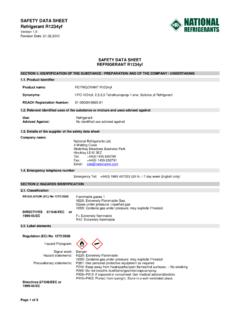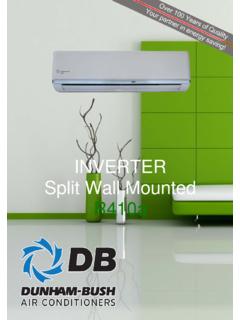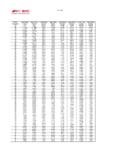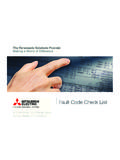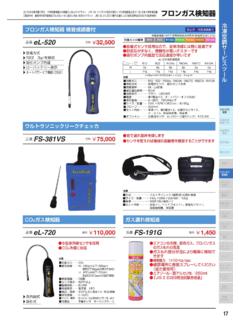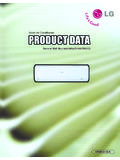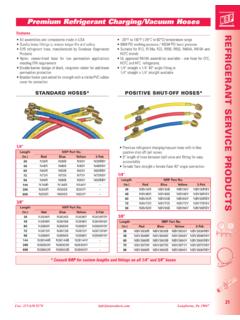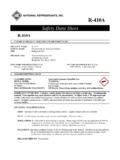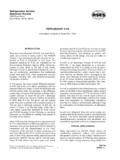Transcription of SAFETY DATA SHEET Refrigerant Gas R410A - National Ref
1 SAFETY data SHEET Refrigerant Gas R410A Version 2 Revision Date: Page 1 of 10 SAFETY data SHEET Refrigerant R410A SECTION 1: IDENTIFICATION OF THE SUBSTANCE / PREPARATION AND OF THE COMPANY / UNDERTAKING Product Identifier Product name: Refrigerant R410A Relevant identified uses of the substance or mixture and uses advised against Use: Refrigerant . Advised Against: No specific uses advised again have been identified, other than restrictions in the F-Gas Regulations. Details of the supplier of the SAFETY data SHEET Company name: National Refrigerants Ltd.
2 4 Watling Close Sketchley Meadows Business Park Hinckley LE10 3EZ Tel: +44(0)1455 630790 Fax: +44(0) 1455 630791 Email: Emergency telephone number Emergency Tel: +44(0) 1865 407333 SECTION 2: HAZARDS IDENTIFICATION Classification of the substance of mixture Classification under Directive 67/548/EEC or 1999/45/EC: This substance is not classified as dangerous according to Directive 67/548/EEC or 1999/45/EC. Most important adverse effect: Rapid evaporation of the liquid may cause frostbite.
3 Vapour is heavier than air and can cause suffocation. Label elements Directives 67/458/EEC or 1999/45/EC: This substance is not classified as dangerous according to Directive 67/548/EEC or 1999/45/EC. Special labelling of certain mixtures: Contains fluorinated greenhouse gases covered by the Kyoto Protocol Other hazards SECTION 3: COMPOSITION / INFORMATION ON INGREDIENTS Substances Hazardous Ingredients: Mixtures DIFLUOROMETHANE (R32) EINECS CAS 67/548/EEC Classification CLP Classification Percent SAFETY data SHEET Refrigerant Gas R410A Version 2 Revision Date: Page 2 of 10 200-839-4 75-10-5 F+.
4 R12 H220: Flammable gas H280: Pressurised gas PENTAFLUOROETHANE (R125) EINECS CAS 67/548/EEC Classification CLP Classification Percent 206-557-8 354-33-6 H280: Pressurised gas SECTION 4: FIRST AID MEASURES Description of first aid measures Skin contact: Take off all contaminated clothing immediately if not stuck to the skin. Flush area with lukewarm water. Do not use hot water. If frostbite has occurred call a physician. Eye contact: Hold eyelids apart and flush eyes with plenty of water for at least 15 minutes.
5 Get medical attention. Ingestion: This is not considered a potential route of exposure. Inhalation: Remove from exposure, lie down. Move to fresh air. Keep patient warm and at rest. Artificial respiration and/or oxygen may be necessary. Consult a physician. General Advice Never give anything by mouth to an unconscious person. When symptome persist or in all cases of doubt seek medical advice. 4. 2. Most important symptoms and effects, both acute and delayed Skin contact: Low exposure will cause redness and pain.
6 High exposure will cause frostbite, blisters and severe pain. Eye contact: Cause severe pain and cornea damage. Ingestion: Not a route of exposure. Inhalation: Shortness of breath, severe headache, dizziness, nausea, weakness, and unconsciousness. Irregular cardiac activity. Treatment: Do not give adrenaline or similar drugs. Indication of any immediate medical attention and special treatment needed Immediate/special treatment: Burns pack should be available on the premises. SECTION 5: FIRE-FIGHTING MEASURES Extinguishing media Extinguishing media: Water spray, Foam, Dry chemical Carbon dioxide (CO2).
7 Use extinguishing measures that are appropriate to local and surrounding environment. Cool cylinders/tanks with water spray. Special hazards arising from the substance or mixture Special hazards arising from the mixture Vapours may form explosive mixtures with air. Vapours are heavier than air and may spread along floors. Vapours or gases may travel considerable distances to ignition source and flash back. Fire or intense heat may cause violent rupture of packages. Hazardous thermal decomposition products: carbon oxides, hydrogen fluoride, carbonyl fluoride.
8 Advice for fire-fighters Advice for fire-fighters: In the event of fire wear self-contained breathing apparatus. Use personal protective equipment. Wear neoprene gloves during cleaning work after a fire. SECTION 6: ACCIDENTAL RELEASE MEASURES SAFETY data SHEET Refrigerant Gas R410A Version 2 Revision Date: Page 3 of 10 Personal precautions, protective equipment and emergency procedures Personal precautions: Evacuate personnel to safe areas. Ventilate the area, especially low or enclosed places where heavy vapours might collect.
9 Environmental precautions Environmental precautions: Should not be released into the atmosphere. Methods and material for containment and cleaning up Clean-up procedures: Material evaporates. Reference to other sections Reference to other sections: Refer to Section 7 of SDS. Refer to Section 8 of SDS. SECTION 7: HANDLING AND STORAGE Precautions for safe handling Handling requirements: Advice on handling: Avoid breathing vapours or mist. Avoid liquid contact with skin and clothing. Provide sufficient air exchange and/or exhaust in work rooms.
10 Advice on protection against fire and explosion: No special measures against fire required. Conditions for safe storage, including any incompatibilities Storage conditions: Do not drag, slide or roll cylinders. Never attempt to lift cylinder by its cap. Use a check valve or trap in the discharge line to prevent hazardous back flow into the cylinder. Keep at temperature not exceeding 52oC. Keep cylinders tightly closed in a dry, cool and well-ventilated place. Suitable packaging: Store in original cylinder only.



